General Sir John Monash, Personal Files Book 18, 28 March - 20 April 1918, Part 8
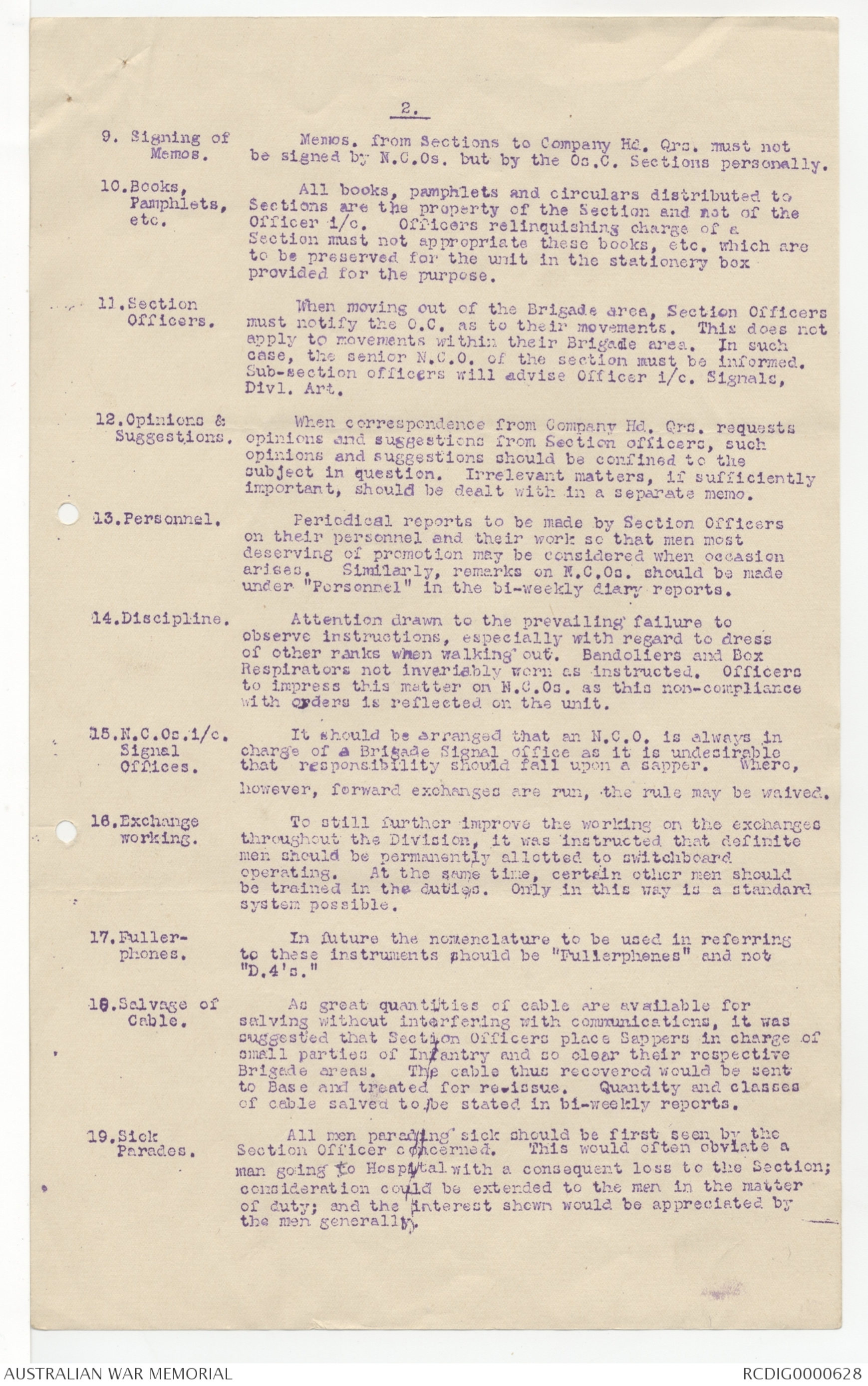
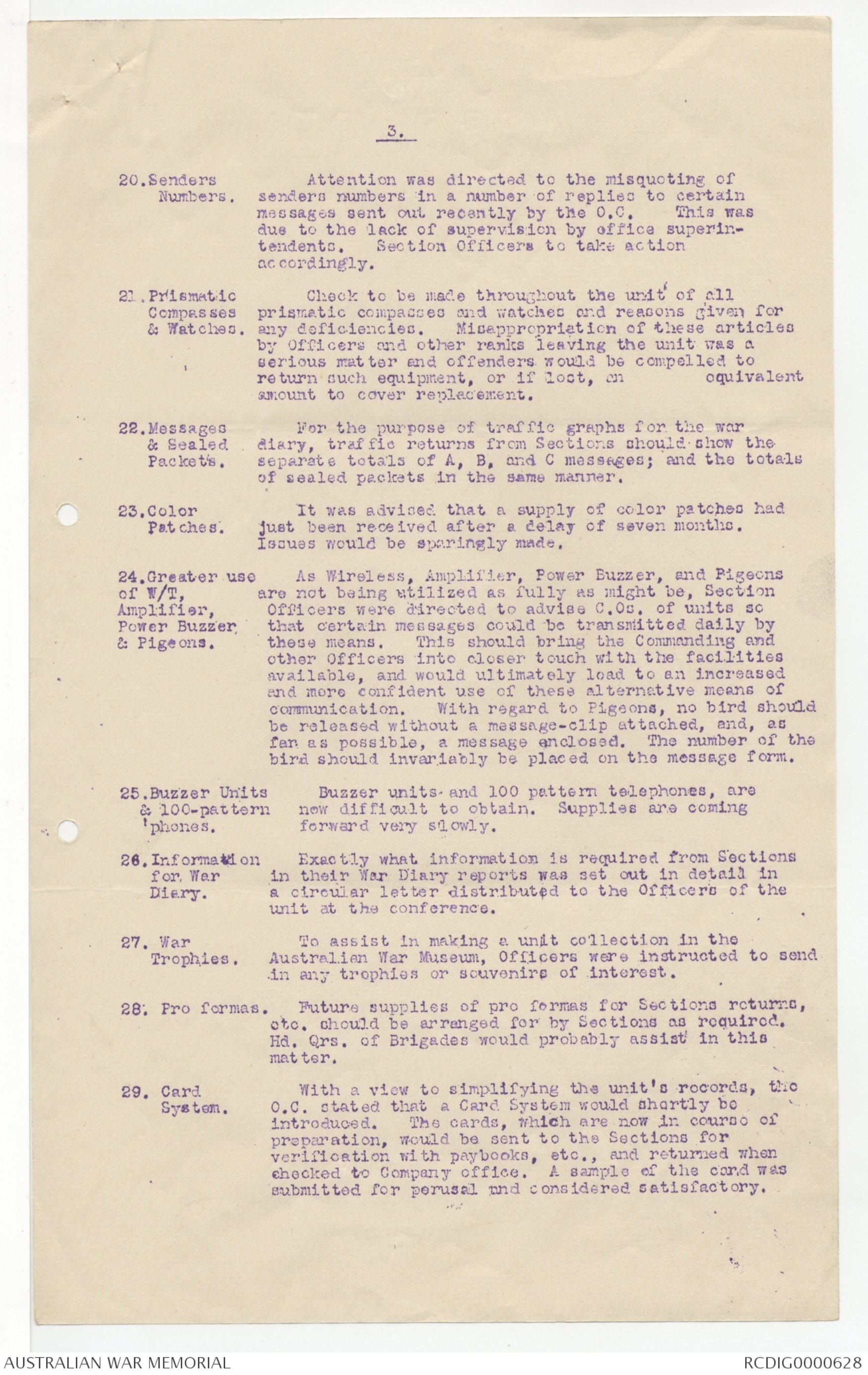
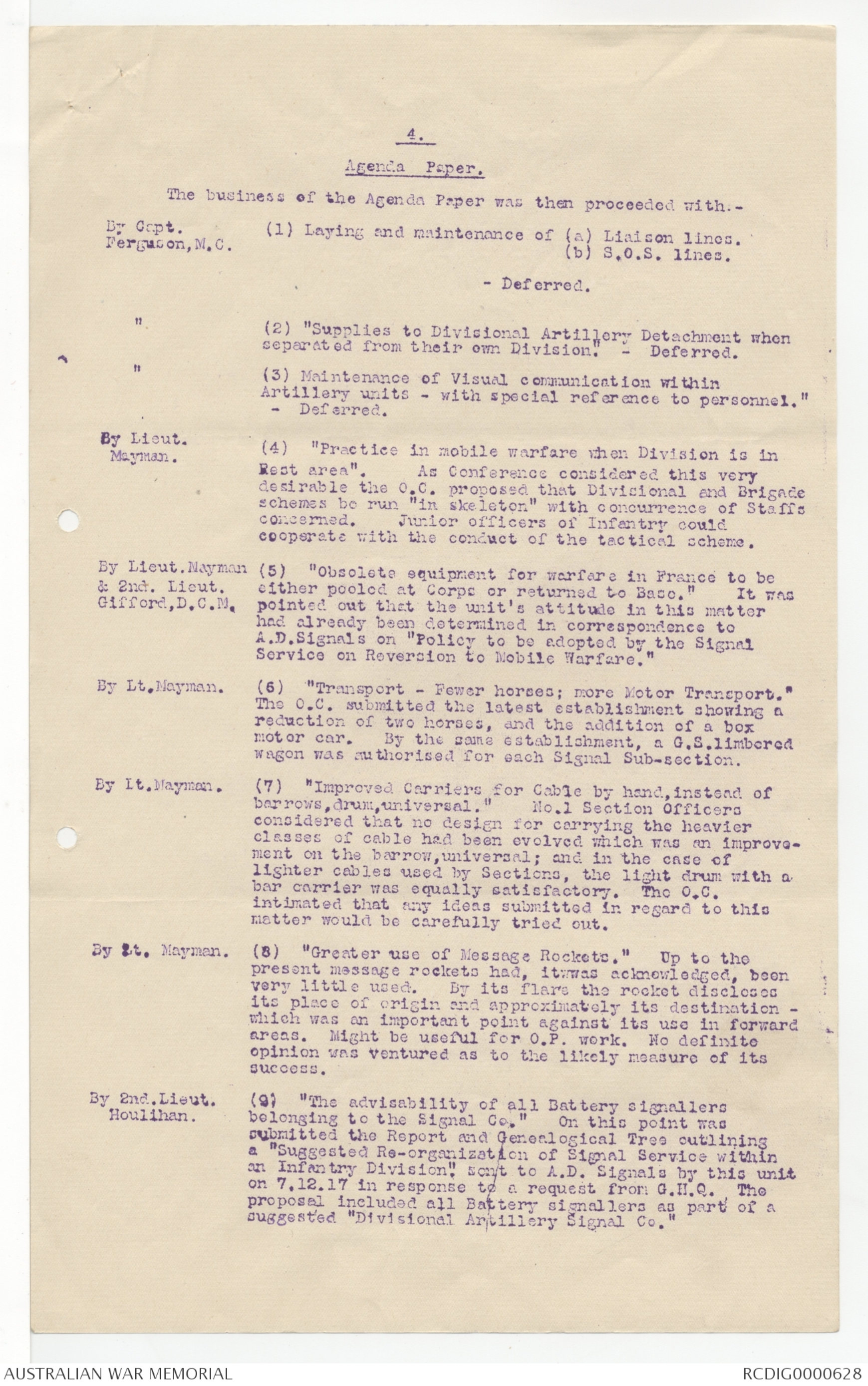
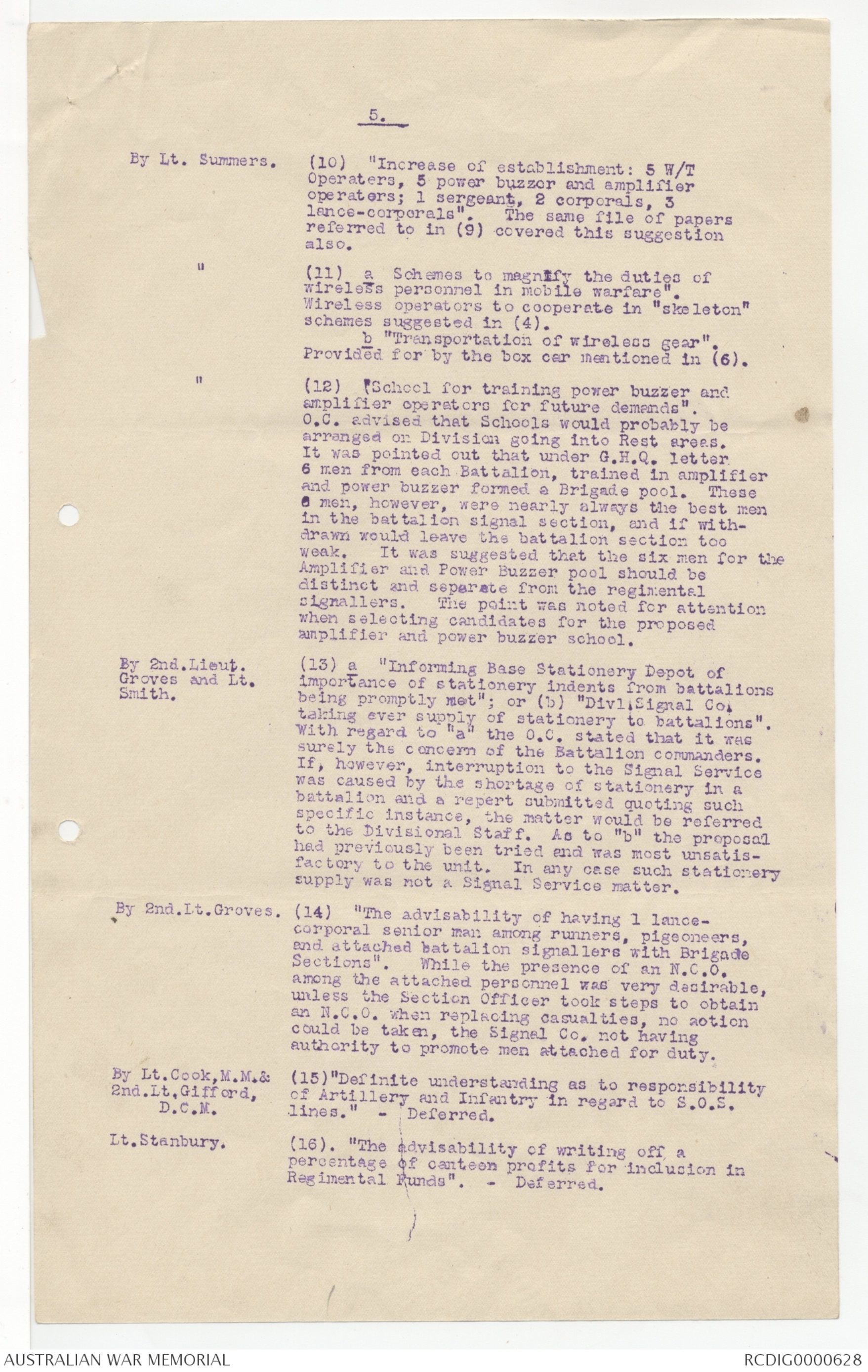
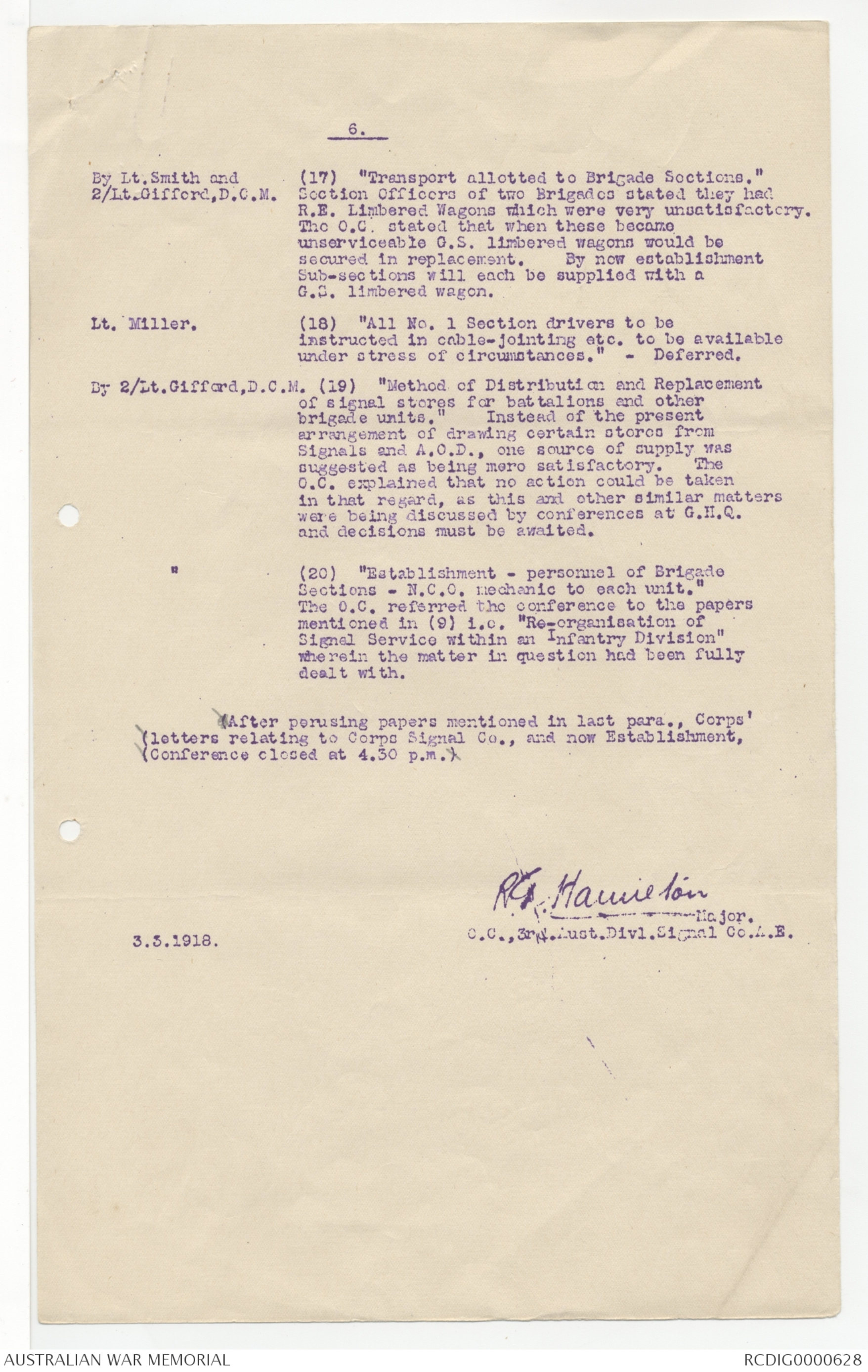
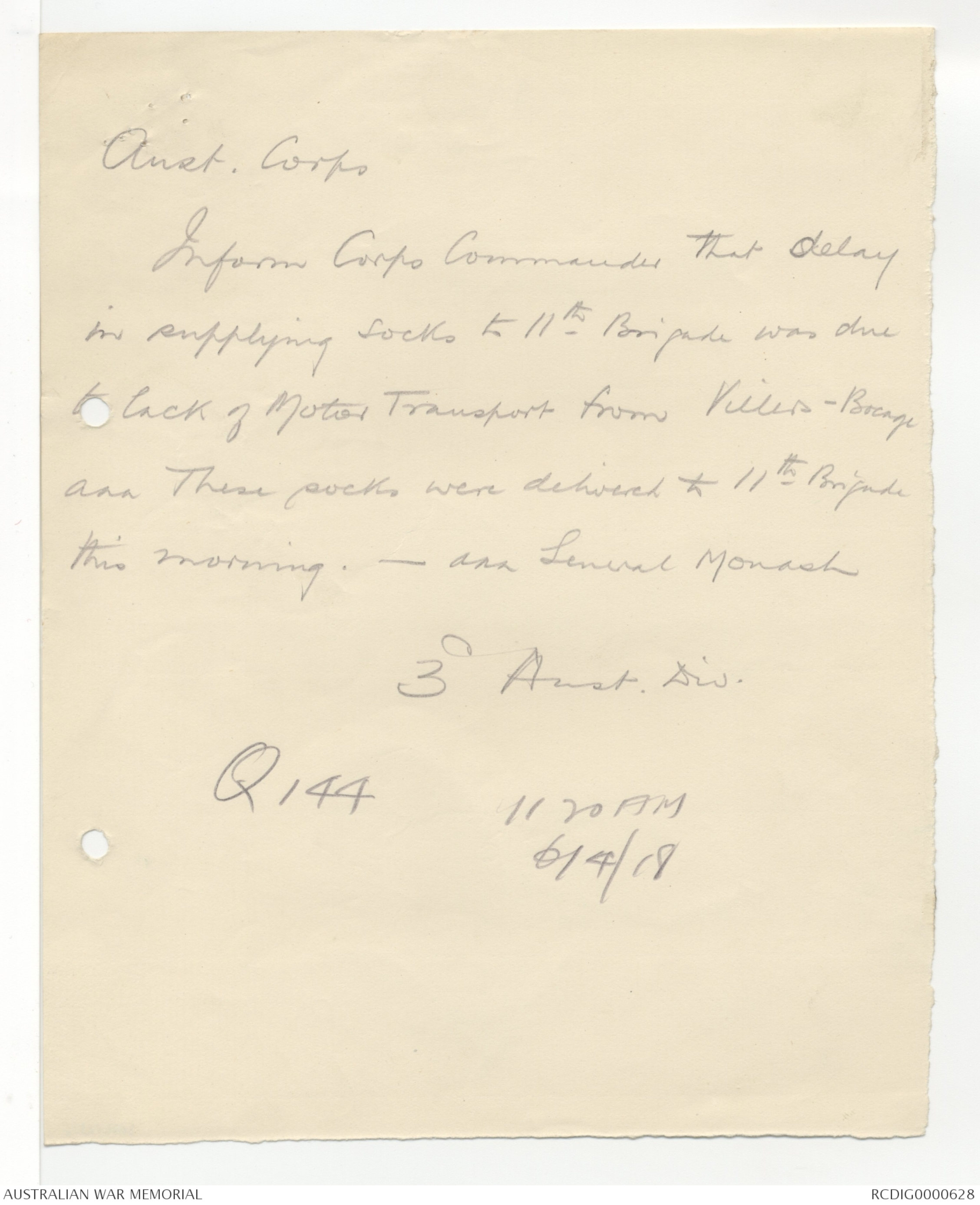
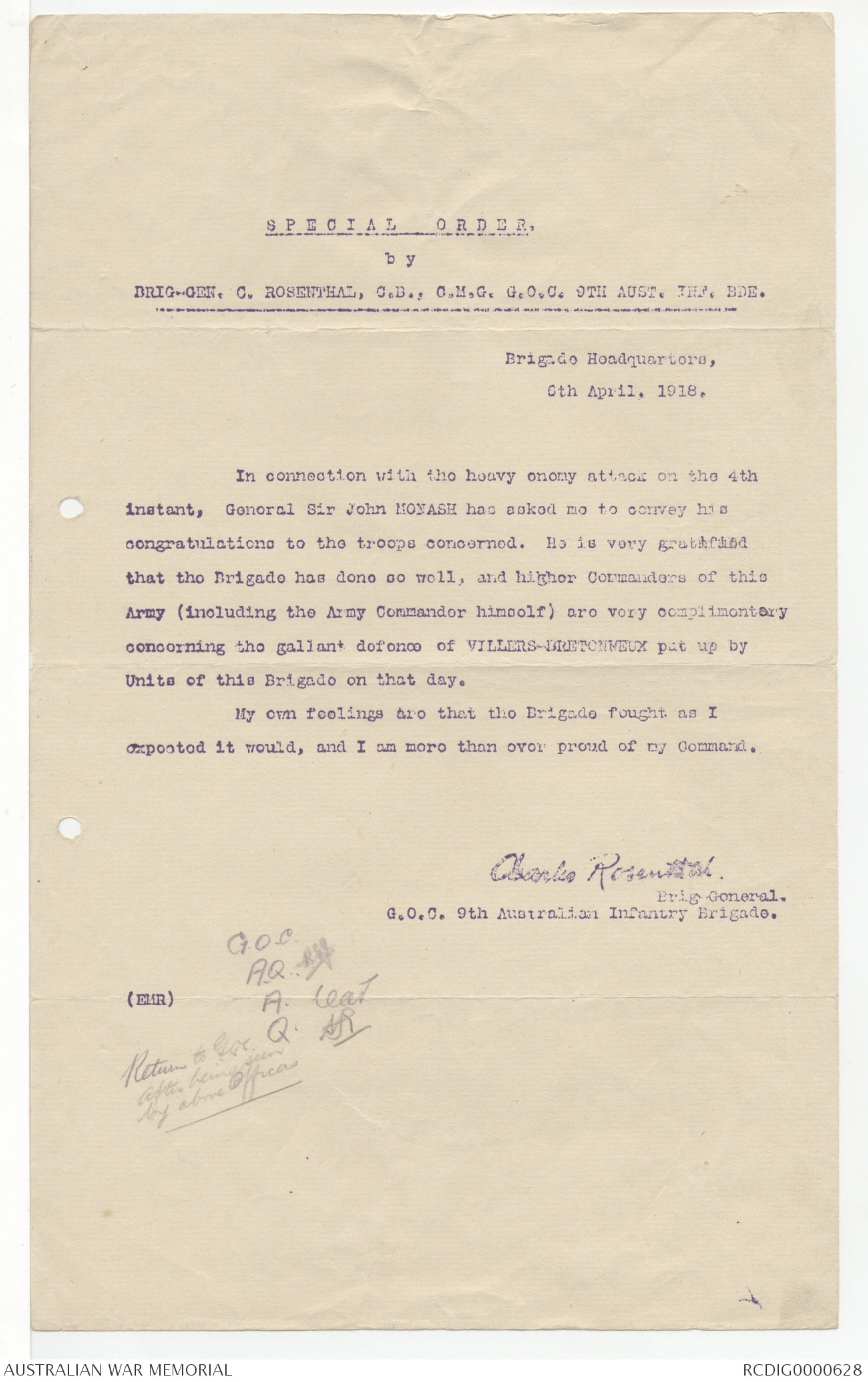
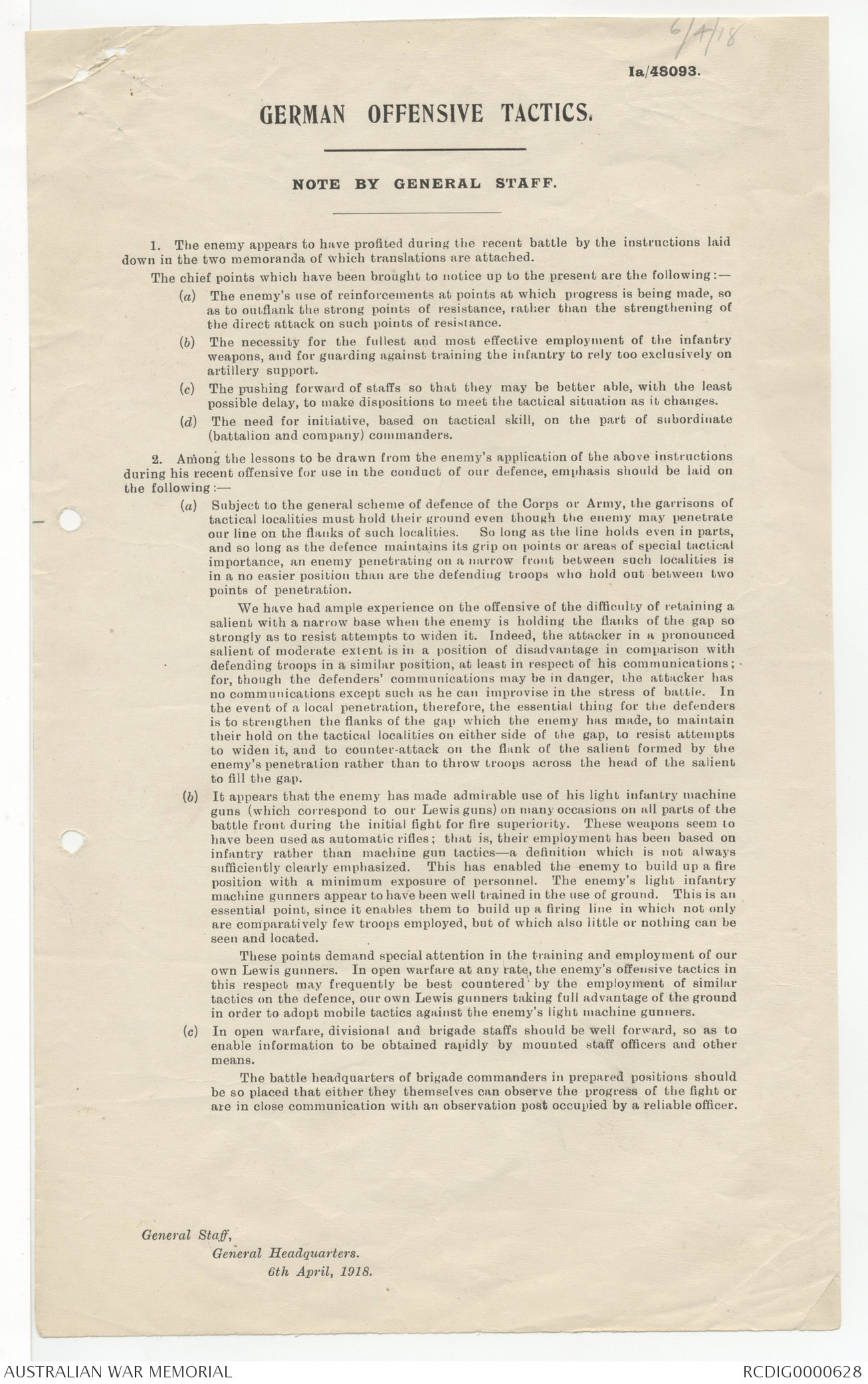


2.
9. Signing of Memos.
Memos. from Sections to Company Hd. Qrs.
must not
be signed by N.C.Os. but by the Os.C. Sections
personally.
10. Books, Pamphlets, etc.
All books, pamphlets and circulars distributed
to
Sections are the property of the Section and
not of the
Officer i/c. Officers relinquishing charge of a
Section must not appropriate these books, etc.
which are
to be preserved for the unit in the stationery
box
provided for the purpose.
11. Section Officers.
When moving out of the Brigade area, Section
Officers
must notify the O.C. as to their movements.
This does not
apply to movements within their Brigade area.
In such
case, the senior N.C.O. of the section must be
informed.
Sub-section officers will advise Officer i/c.
Signals,
Divl. Art.
12. Opinions & Suggestions.
When correspondence from Company Hd. Qrs.
requests
opinions and suggestions from Section officers,
such
opinions and suggestions should be confined
to the
subject in question. Irrelevant matters, if
sufficiently
important, should be dealt with in a separate
memo.
13. Personnel.
Periodical reports to be made by Section
Officers
on their personnel and their work so that men
most
deserving of promotion may be considered
when occasion
arises. Similarly, remarks on N.C.Os. should be
made
under "Personnel" in the bi-weekly diary
reports.
14. Discipline.
Attention drawn to the prevailing failure to
observe instructions, especialloy with regard to
dress
of other ranks when walking out. Bandoliers
and Box
Respirators not invariably worn as instructed.
Officers
to impress this matter on N.C.Os. as this
non-compliance
with orders is reflected on the unit.
15. N.C.Os. i/c. Signal Offices.
It should be arranged that an N.C.O. is always
in
charge of a Brigade Signal office as it is
undesirable
that responsibility should fall upon a sapper.
Where,
however, forward exchanges are run, the rule
may be waived.
16. Exchange working.
To still further improve the working on the
exchanges
throughout the Division, it was instructed that
definite
men should be permanently allotted to
switchboard
operating. At the same time, certain other
men should
be trained in the duties. Only in thise way is
a standard system possible.
17. Fuller-phones.
In future the nomenclature to be used in
referring
to these instruments should be "Fullerphones"
and not
"D.4's."
18. Salvage of Cable.
As great quantities of cable are available for
salving without interfering with
communications, it was
suggested that Section Officers place Sappers
in charge of
small parties of Infantry and so clear their
respective
Brigade areas. The cable thus recovered
would be sent
to Base and treated for re-issue. Quantity
and classes
of cable salved to be stated in bi-weekly
reports.
19. Sick Parades.
All men parading sick should be first seen by
the
Section Officer concerned. This would often
obviate a
man going to Hospital with a consequent loss
to the Section;
consideration could be extended to the men
in the mattter
of duty; and the interest shown would be
appreciated by
the men generally.
3.
20. Senders Numbers.
Attention was directed to the misquoting of
senders numbers in a number of replies to
certain
messages sent out recently by the O.C. This
was
due to the lack of supervision by office
superintendents.
Section Officers to take action
accordingly.
21. Prismatic Compasses & Watches.
Check to be made throughout the unit of all
prismatic compasses and watches and
reasons given for
any deficiencies. Misappropriation of these
articles
by Officers and other ranks leaving the unit
was a
serious matter and offenders would be
compelled to
return such equipment, or if lost, an
equivalent
amount to cover replacement.
22. Messages & Sealed Packets.
For the purpose of traffic graphs for the war
diary, traffic returns from Sections should show
the
separate totals of A, B, and C messages; and
the totals
of sealed packets in the same manner.
23. Color Patches.
It was advised that a supply of color patches
had
just been received after a delay of seven
months.
Issues would be sparingly made.
24. Greater use of W/T, Amplifier, Power Buzzer
& Pigeons.
As Wireless, Amplifier, Power Buzzer, and
Pigeons
are not being utilized as fully as might be,
Section
Officers were directed to advise C.Os. of units
so
that certain messages could be transmitted
daily by
these means. This should bring the
Commanding and
other Officers into closer touch with the
facilities
available, and would ultimately lead to an
increased
and more confident use of these alternative
means of
communication. With regard to Pigeons, no
bird should
be released without message-clip attached,
and, as
far as possible, a message enclosed. The
number of the
bird should invariably be placed on the
message form.
25. Buzzer Units & 100-pattern 'phones.
Buzzer units and 100 pattern telephones,
are
now difficult to obtain. Supplies are coming
forward very slowly.
26. Information for War Diary.
Exactly what information is required from
Sections
in their War Diary reports was set out in detail
in
a circular letter distributed to the Officers of
the
unit at the conference.
27. War Trophies.
To assist in making a unit collection in the
Australian War Museum, Officers were
instructed to send
in any trophies or souvenirs of interest.
28. Pro formas.
Future supplies of pro formas for Sections
returns,
etc. should be arranged for by Sections as
required.
Hd. Qrs. of Brigades would probably assist in
this
matter.
29. Card System.
With a view to simplifying the unit's records,
the
O.C. stated that a Card System would shortly
be
introduced. The cards, which are now in
course of
preparation, would be sent to the Sections for
verification with paybooks, etc., and returned
when
checked to Company office. A sample of the
card was
submitted for perusal and considered
satisfactory.
4.
Agenda Paper.
The business of the Agenda Paper was then proceeded with. -
By Capt. Ferguson, M.C.
(1) Laying and maintenance of
(a) Liaison lines.
(b) S.O.S. lines.
- Deferred.
(2) "Supplies to Divisional Artillery Detachment
when
separated from their own Division."
- Deferred.
(3) Maintenance of Visual communication
within
Artillery units - with special reference to personnel."
- Deferred.
By Lieut. Mayman.
(4) "Practice in mobile warfare when Division
is in
Rest area". As Conference considered this
very
desirable the O.C. proposed that Divisional
and Brigade
schemes be run "in skeleton" with concurrence
of Staffs
concerned. Junior offficers of Infantry could
cooperate with the conduct of the tactical
scheme.
By Lieut. May & 2nd. Lieut. Gifford, D.C.M.
(5) "Obsolete equipment for warfare in France
to be
either pooled at Corps or returned to Base."
It was
pointed out that the unit's attitude in this
matter
had already been determined in
correspondence to
A.D.Signals on "Policy to be adopted by the
Signal
Service on Reversion to Mobile Wafare."
By Lt.Mayman.
(6) "Transport - Fewer horses; more Motor
Transport."
The O.C. submitted the latest establishment
showing a
reduction of two horses, and the addition of
a box
motor car. By the same establishment, a
G.S.limbered
wagon was authorised for each Signal
Sub-section.
By Lt.Mayman.
(7) "Improved Carriers for Cable by hand,
instead of
barrows, drum, universal." No.1 Section Officers
considered that no design for carrying the
heavier
classes of cable had been evolved which was
an improvement
on the barrow, universal; and in the case of
lighter cables used by Sections, the light drum
with a
bar carrier was equally satisfactory. The O.C.
intimated that any ideas submitted in regard
to this
matter would be carefully tried out.
By Lt. Mayman.
(8) "Greater use of Message Rockets." Up to
the
present message rockets had, it was
acknowledged, been
very little used. By its flare the rocket discloses
its place of origin and approximately its
destination -
which was an important point against its use
in forward
areas. Might be useful for O.P. work. No
definite
opinion was ventured as to the likely measure
of its
success.
By 2nd.Lieut. Houlihan.
(9) "The advisability of all Battery signallers
belonging to the Signal Co." On this point was
submitted the Report and Genealogical Tree
outlining
a "Suggested Re-organisation of Signal Service
within
an Infantry Division." sent to A.D. Signals by this
unit
on 7.12.17 in response to a request from G.H.Q.
The
proposal included all Battery signallers as part
of a
suggested "Divisional Artillery Signal Co."
5.
By Lt. Summers.
(10) "Increase of establishment : 5 W/T
Operators, 5 power buzzer and amplifier
operators; 1 sergeant, 2 corporals, 3
lance-corporals". The same file of papers
referred to in (9) covered this suggestion
also.
(11)
a. Schemes to magnify the duties of
wireless personnel in mobile warfare".
Wireless operators to cooperate in "skeleton"
schemes suggested in (4).
b. "Transportation of wireless gear".
Provided for by the box car mentioned in (6).
(12) "School for training power buzzer and
amplifier operators for future demands",
O.C. advised that Schools would probably be
arranged on Division going into Rest areas.
It was pointed out that under G.H.Q. letter
6 men from each Battalion, trained in amplifier
and power buzzer formed a Brigade pool. These
6 men, however, were nearly always the best
men
in the battalion signal section, and if
withdrawn would leave the battalion section
too
weak. It was suggested that the six men for
the
Amplifier and Power Buzzer pool should be
distinct and separate from the regimental
signallers. The point was noted for attention
when selecting candidates for the proposed
amplifier and power buzzer school.
By 2nd.Lieut. Groves and Lt. Smith.
(13)
a. "Informing Base Stationery Depot of
importance of stationery indents from
battalions
being promptly met";
or (b) "Divl,Signal Co.
taking over supply of stationery to battalions".
With regard to "a" the O.C. stated that it was
surely the concern of the Battalion commanders.
If, however, interruption to the Signal Service
was caused by the shortage of stationery in a
battalion and a report submitted quoting such
specific instance, the matter would be referred
to the Divisional Staff. As to "b" the proposal
had previously been tried and was most
unsatisfactory
to the unit. In any case such stationery
supply was not a Signal Service matter.
By 2nd.Lt.Groves.
(14) "The advisability of having 1 lance-
corporal senior man among runners,
pigeoneers,
and attached battalion signallers with Brigade
Sections". While the presence of an N.C.O.
among the attached personnel was very
desirable,
unless the Secion Officer took steps to obtain
an N.C.O. then replacing casualties, no action
could be taken, the Signal Co. not having
authority to promote men attached for duty.
By Lt.Cook,M.M.& 2nd.Lt.Gifford, D.C.M.
(15) "Definite understanding as to responsibility
of Artillery and Infantry in regard to S.O.S.
lines." - Deferred.
Lt.Stanbury.
(16). "The advisability of writing off a
percentage of canteen profits for inclusion in
Regimental Funds". - Deferred
6.
By Lt.Smith and 2/Lt.Gifford, D.C.M.
(17) "Transport allotted to Brigade Sections."
Section Officers of two Brigades stated they
had
R.E. Limbered Wagons which were very
unsatisfactory.
The O.C. stated that when these became
unserviceable O.S. limbered wagons would be
secured in replacement. By now establishment
Sub-sections will each be supplied with a
G.S. limbered wagon.
Lt.Miller.
(18) "All No. 1 Section drivers to be
instructed in cable-jointing etc. to be available
under stress of circumstances." - Deferred.
By 2/Lt.Gifford, D.C.M.
(19) "Method of Distribution and Replacement
of signal stores for battalions and other
brigade units". Instead of the present
arrangement of drawing certain stores from
Signals and A.O.D., one source of supply was
suggested as being more satisfactory. The
O.C. explained that no action could be taken
in that regard, as this and other similar matters
were being discussed by conference at G.H.Q.
and decisions must be awaited.
(20) "Establishment - personnel of Brigade
Sections - N.C.O. mechanic to each unit."
The O.C. referred the conference to the papers
mentioned in (9) i.e. "Re-organisation of
Signal Service within an Infantry Division"
wherein the matter in question had been fully
dealt with.
After perusing papers mentioned in last para.,
Corps'
(letters relating to Corps Signal Co., and now
Establishment,
(Conference closed at 4.30 p.m.)
R. G. Hamilton
Major.
C.C.,3rd.Aust.Divl.Signal Co. A.E
3.3.1918.
Aust. Corps
Inform Corps Commander that delay
in supplying socks to 11th Brigade was due
to lack of Motor Transport from Villers- Bocage
aaa These socks were delivered to 11th Brigade
this morning . - aaa General Monash
3rd Aust. Div.
Q144 11 20 AM
6/4/18
S P E C I A L O R D E R.
by
BRIG-GEN. C. ROSENTHAL, C.B., C.M.G. G.O.C. 9TH AUST. INF. BDE.
Brigade Headquarters,
6th April, 1918.
In connection with the heavy enemy attack on the 4th
instant, General Sir John MONASH has asked me to convey his
congratulations to the troops concerned. He is very gratified
that the Brigade has done so well, and higher Commanders of this
Army (including the Army Commander himself) are very complimentary
concerning the gallant defence of VILLERS-BRETONNEUX put up by
Units of this Brigade on that day.
My own feelings are that the Brigade fought as
I
expected it would, and I am more than ever proud of my Command.
Charles Rosenthal
Brig-General.
G.O.C. 9th Australian Infantry Brigade.
( EMR )
(* G.O.C.
A.Q. [[BEG?]]
A. [[CaT?]]
Q. S R *)
(* Return to G.O.C.
after being seen
by above Officers. *)
6/4/18
1a/48093.
GERMAN OFFENSIVE TACTICS.
______________________
NOTE BY GENERAL STAFF.
_______________________
- The enemy appears to have profited during
the recent battle by the instructions laid
down in the two memoranda of which
translations are attached.
The chief points which have been brought to
notice up to the present are the following : -
(a) The enemy's use of reinforcements at
points at which progress is being made, so
as to outflank the strong points of resistance,
rather than the strengthening of
the direct attack on such points of resistance.
(b) The necessity for the fullest and most
effective employment of the infantry
weapons, and for guarding against training the
infantry to rely too exclusively on
artillery support.
(c) The pushing forward of staffs so that they
may be better able, with the least
possible delay, to make dispositions to meet
the tactical situation as it changes.
(d) The need for initiative, based on tactical
skill, on the part of subordinate
(battalion and company) commanders.
2. Among the lessons to be drawn from the
enemy's application of the above instructions
during his recent offensive for use in the
conduct of our defence, emphasis should be
laid on the following : -
(a) Subject to the general scheme of defence
of the Corps or Army, the garrisons of
tactical localities must hold their ground even
though the enemy may penetrate
our line on the flanks of such localities. So long
as the line holds even in parts,
and so long as the defence maintains its grip
on points or areas of special tactical
importance, an enemy penetrating on a narrow
front between such localities is
in a no easier position than are the defending
troops who hold out between two
points of penetration.
We have had ample experience on the
offensive of the difficulty of retaining a
salient with a narrow base when the enemy is
holding the flanks of the gap so
strongly as to resist attempts to widen it.
Indeed, the attacker in a pronounced
salient of moderate extent is in a position of
disadvantage in comparison with
defending troops in a similar position, at least
in respect of his communications;
for, though the defenders' communications
may be in danger, the attacker has
no communications except such as he can
improvise in the stress of battle. In
the event of a local penetration, therefore, the
essential thing for the defenders
is to strengthen the flanks of the gap which the
enemy has made, to maintain
their hold on the tactical localities on either
side of the gap, to resist attempts
to widen it, and to counter-attack on the flank
of the salient formed by the
enemy's penetration rather than to throw
troops across the head of the salient
to fill the gap.
(b) It appears that the enemy has made
admirable use of his light infantry machine
guns (which correspond to our Lewis guns) on
many occasions on all parts of the
battle front during the initial fight for fire
superiority. These weapons seem to
have been used as automatic rifles; that is,
their employment has been based on
infantry rather than machine gun tactics - a
definition which not always
sufficiently clearly emphasized. This has
enabled the enemy to build up a fire
position with a minimum exposure of
personnel. The enemy's light infantry
machine gunners appear to have been well
trained in the use of ground. This is an
essential point, since it enables them to build
up a firing line in which not only
are comparatively few troops employed, but of
which also little or nothing can be
seen and located.
These points demand special attention in the
training and employment of our
own Lewis gunners. In open warfare at any
rate, the enemy's offensive tactics in
this respect may frequently be best countered
by the employment of similar
tactics on the defence, our own Lewis gunners
taking full advantage of the ground
in order to adopt mobile tactics against the
enemy's light machine gunners.
(c) In open warfare, divisional and brigade
staffs should be well forward, so as to
enable information to be obtained rapidly by
mounted staff officers and other
means.
The battle headquarters of brigade
commanders in prepared positions should
be so placed that either they themselves can
observe the progress of the fight or
are in close communication with an
observation post occupied by a reliable officer.
General Staff,
General Headquarters.
6th April, 1918.
1a/48093.
TRANSLATION OF GERMAN DOCUMENTS
———————————
A. - NOTES ON THE OFFENSIVE BATTLE.
Ia/11, Nr. 6220 (Secret). General Headquarters,
25-1-18.
The results of my tactical conferences will be issued in the "Supplement," dated 1-2-18,
to Part 14 of the "Manual of Position Warfare for All Arms."
I desire to call attention to the following
points :-
1. The idea that our attacking divisions must be relieved after one day's fighting cannot
be entertained. On the contrary, the infantry must, by skilful tactical leading, preserve its
fighting strength, so that divisions are capable of carrying out offensive battles of several days'
duration and entailing a considerable advance.
I request that this principle be made generally
known throughout the Army.
2. (a) Even in case of minor operations, the offensive must be carried 8 km. or more,
in specified sectors of attack, through a hostile defensive system and across numerous obstacles,
up to and beyond the enemy's artillery.
The attack in combination with troops on either flank must also be practised, based on
similar principles. The scheme will, whenever possible, be set by higher authority.
Arrangements for representing the enemy and for providing umpires are of importance.
(b) In these practice attacks, the principle must be clearly emphasized that the success
of an attack does not consist only in a careful engagement and assembly of the attacking troops
and in the execution of a methodically considered attack, but that skilful leardership on the part
of higher and subordinate commanders, in accordance with the tactical situation at the moment,
is required in addition during the actual attack.
Our attack must differ essentially in this respect from the attacks hitherto undertaken by
the British. The British believed in the efficacy of their skilfully worked out but rigid
artillery barrage; this was to carry forward the infantry attack, which advanced without any
impetus of its own. The subordinate, and, still more, the higher commanders ceased to have
any further influence.
In the various British offensives - Somme, Arras, Messines, Flanders, Cambrai - the initial
tactical successes, which were frequently very considerable, were not seized upon and were not
usefully exploited. A defeat was eventually the outcome of this narrow-minded principle on
which the conduct of the battle and the leadership was based.
As in open warfare, so also in the break through, free play must be allowed, from the
opening of the artillery barrage, for the fullest independence and tactical skill of the subordinate
commanders from company or battalion commanders upwards. The decision will often depend
on the action of the subordinate commanders.
The higher commands (Divisions, Groups and Armies) are even more important in the
offensive. For these, the most important matters are economy of force and the proper
engagement of the reserves. These will, as a general rule, not be thrown into the battle at
points when the attack has been held up by strong points and centres of resistance, and
where unnecessary sacrifice is involved, but at points where the attack is still in movement
and its progress can be facilitated with a view to breaking down the enemy's resistance in the
neighbouring sector by rolling it up from flank and rear.
This applies particularly to the bringing up and engagement of the 2nd and 3rd line divisions,
which Corps and Armies must consider as their reserves, and must bring up and engage at the
right time. Premature engagement of the reserves invariably uses up the force of the attack
and brings the offensive movement to a standstill before the break through has been effected.
On the other hand, it is the duty of every commander to keep the reserves up so close that every
reverse can be prevented, every success properly exploited and the offensive continued.
The position of the commander is of considerable importance. All staffs, including Corps
staffs, must be on the battlefield, the divisional staffs being pushed well forward.
(c) The success of every break through will depend on the timely bringing up of light and
heavy artillery, with its ammunition, as well as sufficient light Minenwerfer on flat-trajectory
carriages.
(d) In particular, the artillery barrage should prepare the way for the infantry after the
latter has penetrated the 1st line. The forward movement of the barrage will depend on the
rate of the infantry advance.
Note. - The captured copy of this document is not signed, but a note describes it as a
"Verfugung von Ludendorff," and it was presumably issued under Ludendorff's
signature.
[P.T.O
B. - MEMORANDUM DEALING WITH THE TACTICS OF THE OFFENSIVE.
C.G.S. of the Field Army. 8-2-18.
II Nr. 6405. Secret. op.
1. The endeavour to effect surprise must not
lead to hasty preparations and particularly
not to excessive curtailment of the artillery
preparation. In the case of an attack on a large
scale, the advantage of surprise to the attacker lies chiefly in the fact that he is enabled to make
his dispositions first and, secondly, in the uncertainty of the defender as to the actual day
hour of the attack. The attack must be framed on correct tactical principles which
guarantee success.
2. Decisive role of commanders of all ranks and arms. The attack does not go on merely
mechanically ; commanders must command ; every man must act on his own initiative.
3. . . . . . .
4. Counter-battery work, with careful observation, must be increased on all fronts before
the commencement of the attack.
5. Too little importance appears to be attached to the neutralization of the enemy's
artillery during the attack.
6. The artillery preparation should not take longer than is necessary. The fact should
not be overlooked that a one hour's bombardment is not sufficient to obtain a satisfactory
destructive effect. The chief difficulty lies in the satisfactory destruction of the rearward
positions (particularly the wire).
7. . . . . . .
8. . . . . . . Emphasis must be repeatedly laid on the fact that the barrage
will
never form a thick curtain of fire, and that it
cannot save the infantry from the necessity of
carrying out the close combat with machine
gun, rifle and bayonet, grenade, light
Minenwerfer
and guns accompanying it, but that it can only
facilitate this combat. Also, that the barrage
is only of value if the infantry keeps close up to it and continually endeavours to advance
right into our own (artillery) fire, in the manner taught in the assault battalions.
The barrage must be lifted in accordance with a time table. If signals are employed in
addition, they must be simple and their number must be restricted. It is desirable that there
should be only one signal, either to cause barrage to advance ("Lift barrage") or to cause
it to halt ("Halt barrage"). The order to halt the barrage should only hold good for a short
period, for instance for 10 minutes. . . . .
9. . . . . . . .
10. The success with which the artillery comes into action will be decisively influenced by
good cover against air observation.
11. Batteries will be detailed as batteries "in positions in readiness" and to engage
fleeting targets, and will be employed as such.
12. An advance of the infantry in waves, the number of waves corresponding to the number
of hostile lines which may be expected to offer resistance, and during which the rearward
waves are intended to overtake the preceding waves, is to be deprecated. The foremost
infantry should, on the contrary, advance as long as it possibly can and should only be
reinforced from the rear when this is absolutely necessary. A sufficient distribution in depth
to ensure against a counter-offensive (flanks) must be continually maintained.
13. Too little importance is now attached to the fire support of the infantry with the
means at its disposal, as practised by us in peace time with our advance by rushes. Not only
should the infantry be helped forward by the artillery firing from positions far in rear, by the
batteries accompanying the infantry and by the light Minenwerfer, but it should also be
principally assisted by the machine gun and rifle fire of the infantry itself.
Short, surprise bursts of machine gun fire, varied methodically, and directed against
important points in the back area, will frequently be effective in disturbing traffic and
communications, especially before the attack begins.
14. In view of the scarcity of forage, it is absolutely essential that the work to be done by
the horses should be proportional to the forage issued. This is also necessary in connection
with the preparatory work now going on, as the supply of forage, though it will be more regularly
maintained, will not be appreciably increased. It must, therefore, be a guiding principle to save
the horses as much as possible.
(Signed) Ludendorff.
__________________________________
Printing Section Depot F.S.C.,R.E. G.H.Q. 1452x.
(* 3 DRL 12316 *)
 Transcriber 27924
Transcriber 27924This transcription item is now locked to you for editing. To release the lock either Save your changes or Cancel.
This lock will be automatically released after 60 minutes of inactivity.